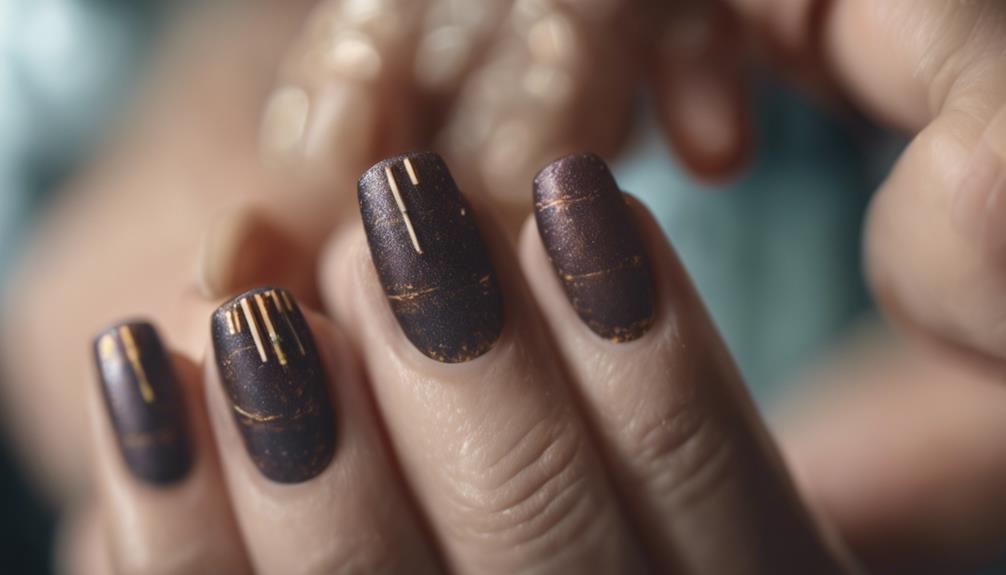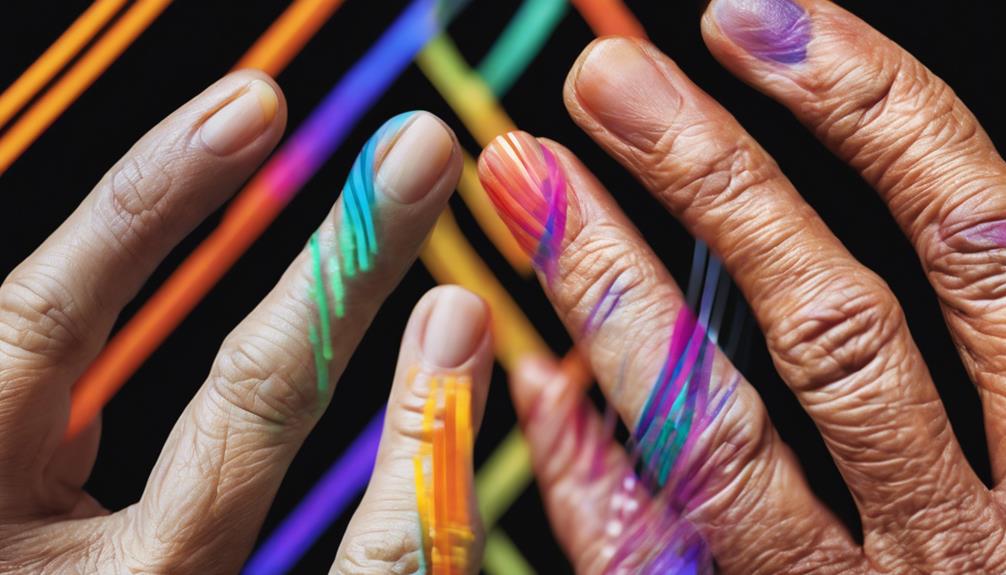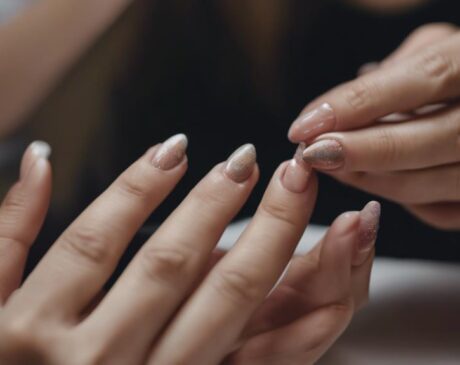Do Finger Nails Grow Faster as You Age?

Nail growth tends to slow down as individuals age. Factors like genetics, health, and hormonal changes influence nail growth speed. Aging affects metabolic rates, collagen production, and circulation, impacting nail health. However, myths about nail growth persist. Tip: Maintain healthy nails by keeping them clean, moisturized, and well-trimmed. Understanding nail growth cycles can aid in proper care. The dynamic relationship between aging and nail growth is an intriguing subject worthy of exploration.
Key Takeaways
- Nail growth slows with age due to reduced metabolic rate and hormonal changes.
- Aging decreases blood circulation affecting nutrient delivery to nails.
- Collagen decline and moisture loss in aging influence nail growth speed.
- Geriatric dermatology advancements provide insights to maintain nail health in older age.
- Proper nail care, hydration, and nutrition are crucial for healthy nail growth throughout life.
Factors Influencing Nail Growth Rate

Factors that influence the rate at which nails grow include various biological and environmental factors. Biologically, nail growth is primarily determined by genetics, with some individuals naturally experiencing faster growth rates than others. Additionally, factors such as age, overall health, and hormonal fluctuations can play a role in the speed of nail growth. Environmental factors, such as nutrition, hydration levels, and exposure to chemicals or trauma, also impact the rate at which nails grow.
Innovations in nail care products and techniques have further demonstrated the potential to influence nail growth rates. For example, certain nail treatments enriched with vitamins, minerals, or proteins claim to promote faster and healthier nail growth. Similarly, advancements in nail technology, such as gel manicures and strengthening polishes, may provide additional support for faster nail growth by improving nail durability and reducing breakage.
Understanding the intricate interplay between biological and environmental factors is crucial for those seeking to optimize nail growth rates and maintain overall nail health. By staying informed about the latest innovations in nail care, individuals can make informed choices to support optimal nail growth.
Changes in Nail Growth With Age
As individuals age, the rate of nail growth may undergo noticeable changes influenced by a combination of intrinsic and extrinsic factors. One key factor contributing to changes in nail growth with age is the gradual decrease in metabolic rate, which can result in slower cell turnover and ultimately affect the rate at which nails grow. Additionally, hormonal fluctuations that occur during the aging process can impact the health and growth of nails.
Moreover, changes in blood circulation, which tend to decrease as we age, can also play a role in the rate of nail growth. Poor circulation can lead to reduced nutrient delivery to the nail matrix, affecting the overall growth and quality of nails. Furthermore, age-related changes in the nail matrix itself, such as a decline in collagen production and decreased moisture retention, can influence the speed at which nails grow.
Innovations in the field of geriatric dermatology continue to shed light on the complex interplay of factors that contribute to changes in nail growth with age, offering new insights and potential interventions to maintain nail health in older individuals.
Myths Versus Scientific Evidence

In the realm of nail growth and aging, distinguishing between commonly held myths and scientifically supported evidence is crucial for understanding the dynamics at play. One prevalent myth is that nails continue to grow at a faster rate as individuals age. However, scientific research indicates that nail growth rates actually tend to slow down with age. The misconception might stem from the fact that older individuals' nails appear thicker due to changes in the nail matrix and decreased circulation, rather than actual accelerated growth.
Another myth suggests that applying nail polish or using acrylic nails can hinder natural nail growth. While improper application or prolonged use of certain products can weaken nails, leading to breakage and brittleness, there is no concrete evidence to support the claim that these practices inherently impede nail growth. In fact, maintaining proper nail care and hygiene can promote healthy nail growth regardless of cosmetic enhancements.
Tips for Maintaining Healthy Nails
Seeking to cultivate strong and healthy nails that exude vitality and resilience, what fundamental practices can individuals incorporate into their nail care routine? To maintain healthy nails, it is crucial to keep them clean and dry to prevent bacterial or fungal infections. Regularly trim nails straight across and file them to maintain a smooth edge, reducing the risk of ingrown nails. Moisturizing cuticles and nails with nourishing oils or creams helps prevent brittleness and breakage. Wearing gloves while performing tasks that expose nails to harsh chemicals or excessive moisture can safeguard their strength. A balanced diet rich in vitamins, minerals, and proteins promotes nail health from within. Avoiding nail biting and using nails as tools can prevent damage and maintain their integrity. Lastly, giving nails occasional breaks from nail polish and allowing them to breathe can contribute to their overall health. By incorporating these practices into a nail care routine, individuals can promote the strength and vitality of their nails, fostering a polished and healthy appearance.
Understanding Nail Growth Patterns

One of the fascinating aspects of nail care is understanding the intricate patterns of nail growth. Nail growth follows a specific pattern that consists of four stages: the Anagen phase, Catagen phase, Telogen phase, and Exogen phase. In the Anagen phase, the nail actively grows from the matrix, the root of the nail. This phase typically lasts for 2-3 months for fingernails and longer for toenails. The Catagen phase is a transitional period where nail growth slows down, lasting for about 1-2 weeks. Following this, the Telogen phase is a resting period that allows the nail to detach from the nail bed, lasting for around 4-5 months. Lastly, the Exogen phase is the shedding phase where the old nail is pushed out by the new nail growing underneath. Understanding these growth patterns can help individuals appreciate the natural rhythm of their nails and tailor their nail care routines accordingly.
Frequently Asked Questions
Can Certain Health Conditions or Medications Affect the Rate of Nail Growth in Older Individuals?
Certain health conditions and medications can indeed influence the rate of nail growth in older individuals. Factors like nutritional deficiencies, thyroid disorders, and chemotherapy can alter the speed and quality of nail growth, necessitating tailored treatment approaches.
Is There a Correlation Between Nail Growth Speed and Overall Health in Older Adults?
In older adults, nail growth speed may correlate with overall health indicators. Research suggests that factors like nutrition, circulation, and hormonal balance can influence nail growth rates, highlighting the potential role of health in this process.
Are There Specific Dietary Habits That Can Promote Faster Nail Growth in Seniors?
Optimal dietary habits, rich in protein, biotin, and essential vitamins like A, B, C, and D, can potentially promote faster nail growth in seniors. A balanced diet with nutrients crucial for nail health may support this outcome.
Do Nail Growth Patterns Vary Between Different Ethnicities or Genetic Backgrounds?
Nail growth patterns can vary significantly based on a person's ethnic background or genetic makeup. Research shows that these factors influence the rate and characteristics of nail growth, highlighting the uniqueness of nail biology across diverse populations.
How Does Climate or Seasonal Changes Impact the Growth Rate of Nails as Individuals Age?
Climate and seasonal changes can influence nail growth rates as individuals age. Factors like temperature, humidity, and sunlight exposure may impact nail health and growth. Research into these variables could provide insights into this intriguing phenomenon.




